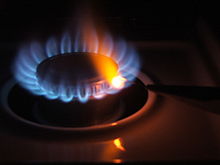Drummond's light
The Drummondsche light , even limelight called, was a 1826 presented lighting source in which an oxygen-hydrogen flame , which on a piece of lime , brings this is directed to intense lights. The English term limelight (from English limestone ) for spotlight , which is still in use today, goes back to this historical light source.
construction
The oxyhydrogen flame brings the piece of quicklime to white heat without melting it.
The lighting equipment was relatively difficult to use. The hydrogen gas had to be produced in a complex and costly manner, and there was always the risk of an oxyhydrogen gas explosion.
history
The limestone light is named after Sir Thomas Drummond (1797–1840). At a demonstration by Michael Faraday of the effect discovered by Goldsworthy Gurney , Drummond was present and developed a useful light source from it.
Due to the glistening bright light, the limestone light was used as a beacon in lighthouses , in theater lighting (especially in the spotlight ) and in early cinematographs and gas microscopes .
One of the first known uses for performances was on the Herne Bay Pier in Herne Bay in Kent on October 3, 1836 on the occasion of the celebration of the laying of the foundation stone of the clock tower, when the magician Ching Lau Lauro had his juggling number illuminated with what it was called koniaphostic light , that bathed the entire pier in white light. It was first used in a theater in 1837 ( Covent Garden Theater) and found worldwide distribution in theaters and music halls in the 1860s and 1870s.
Because of its disadvantages, the lime light was replaced by the carbon arc lamp towards the end of the 19th century .
See also
literature
- Pierre Lauginie: Drummond Light, Limelight: a Device of its Time. In: Bulletin of the Scientific Instrument Society. No. 127 (2015), pp. 22–28 ( digitized version ).
- Jan Evangelista Purkyně : microscopic specimens demonstrated with the aid of Drummond's lighting apparatus. In: Overview of the work and changes of the Silesian Society for Patriotic Culture in 1938. Breslau 1840, p. 82.
- F. Paul Liesegang: Handbook of practical cinematography. Ed. Liesegang's Verlag, M. Eger, Leipzig 1911, p. 152ff. ( Project Gutenberg eBook )
- F. Paul Liesegang: Photography and cinema technology. Light stage library No. 1, Volksvereins-Verlag GmbH., M. Gladbach 1913, p. 26ff. ( Project Gutenberg eBook )
Web links
- Description of the experiment with video on the website of the Georg-August-Universität Göttingen
- LIME: CALCIUM OXIDE - CaO (English)


